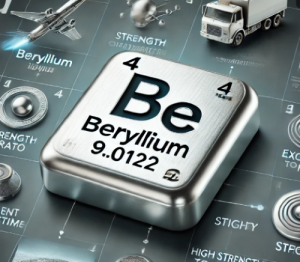Beryllium: Understanding Its Toxicity and Safety Measures

Introduction
Beryllium is a lightweight metal with remarkable properties that make it invaluable in various high-tech industries. However, its benefits are accompanied by significant health risks, particularly when its dust or fumes are inhaled. This article explores the toxicity of beryllium, its characteristics, the diseases it can cause, and the measures to protect workers from its harmful effects.

What Is Beryllium?
Beryllium is a chemical element with the symbol Be and atomic number 4. It is a steel-gray, strong, lightweight, and brittle alkaline earth metal. Known for its rigidity and high melting point, Be is primarily used as an alloying agent in aerospace, electronics, defense, and nuclear industries. Its ability to slow down neutrons makes it a critical component in nuclear reactors. Be's transparency to X-rays also renders it useful in medical imaging equipment.
Related reading: 6 Common Uses Of Beryllium
Is Beryllium Harmful?
Yes, it is harmful, particularly in its powdered or fume form. When Be dust or fumes are inhaled, they can cause serious lung conditions, including chronic beryllium disease (CBD) and beryllium sensitization (BeS). Beryllium exposure can occur in workplaces where Be-containing materials are manufactured, processed, or recycled. The risk of exposure is particularly high in industries such as aerospace, electronics, ceramics, and nuclear power.
OSHA estimates that approximately 62,000 workers across about 7,300 establishments in the United States are potentially exposed to beryllium, including around 12,000 workers in the construction and shipyard industries. [1]
In general industry, occupations with potential Be exposure include primary beryllium production workers, workers processing beryllium metal, alloys, or composites, foundry workers, furnace tenders, machine operators, machinists, metal fabricators, welders, dental technicians, secondary smelting and refining workers (recycling electronic and computer parts, metals), and abrasive blasters.
What’s the Symptom?
Exposure to beryllium can lead to several health issues, primarily affecting the respiratory system. The symptoms can vary depending on the specific condition caused by the exposure.
1. Chronic Beryllium Disease (CBD)
CBD is a debilitating lung disease that results from an immune response to inhaled beryllium particles. Symptoms of CBD can develop many years after initial exposure and include:
- Persistent cough
- Shortness of breath
- Fatigue
- Chest pain
- Loss of appetite and weight loss
- Fever and night sweats
CBD occurs when the immune system recognizes Be particles as foreign and mounts an inflammatory response, leading to the formation of granulomas (small inflammatory nodules) in the lungs. This can cause lung scarring and reduce the ability to breathe efficiently.
2. Beryllium Sensitization (BeS)
Beryllium sensitization is an immune response that occurs when a person becomes allergic to beryllium. Unlike CBD, BeS does not cause symptoms on its own but indicates an increased risk of developing CBD in the future. BeS can be detected through a blood test known as the Beryllium Lymphocyte Proliferation Test (BeLPT). Individuals with BeS must be monitored regularly for signs of CBD.
3. Other Diseases
In addition to CBD and BeS, beryllium exposure can lead to other health issues, including:
- Acute Beryllium Disease (ABD): This is a rare and severe form of lung disease that occurs shortly after high levels of Be exposure. Symptoms include coughing, difficulty breathing, and chest pain.
- Skin Conditions: Direct contact with beryllium can cause skin ulcers and rashes.
- Cancer: Beryllium is classified as a carcinogen, meaning long-term exposure can increase the risk of lung cancer.
How to Protect Workers?
To protect workers from the harmful effects of beryllium, employers must implement strict safety measures. These include:
1. Engineering Controls
- Ventilation Systems: Use local exhaust ventilation systems to capture Be dust and fumes at the source.
- Enclosed Processes: Enclose processes that generate Be dust or fumes to minimize airborne exposure.
- Wet Methods: Utilize wet methods to suppress dust during cutting, grinding, or other operations.
2. Administrative Controls
- Exposure Monitoring: Regularly monitor air levels of beryllium to ensure they are within permissible exposure limits.
- Medical Surveillance: Implement medical surveillance programs to monitor the health of workers exposed to Be, including regular lung function tests and BeLPT.
- Training and Education: Provide comprehensive training to workers about the risks of Be exposure and safe work practices.
3. Personal Protective Equipment (PPE)
- Respiratory Protection: Provide appropriate respirators to workers in areas where beryllium dust or fumes may be present.
- Protective Clothing: Use disposable or washable protective clothing to prevent skin contact with beryllium.
- Personal Hygiene: Ensure workers wash their hands and face before eating, drinking, or smoking to prevent ingestion of beryllium particles.
4. Housekeeping and Maintenance
- Regular Cleaning: Implement regular cleaning schedules using vacuum systems with HEPA filters to remove beryllium dust from work areas.
- Waste Management: Properly dispose of beryllium-containing waste materials to prevent environmental contamination.
Conclusion
While beryllium's unique properties make it essential for various industries, its potential health risks cannot be ignored. Chronic beryllium disease, beryllium sensitization, and other related health issues highlight the need for stringent safety measures in workplaces. By implementing engineering controls, administrative controls, personal protective equipment, and rigorous housekeeping practices, employers can significantly reduce the risk of beryllium exposure and protect the health and well-being of their workers. For more details, please check Advanced Refractory Metals (ARM).
Reference:
[1] (2024, July 30). Beryllium. Occupational Safety and Health Administration. Retrieved July 30, 2024, from https://www.osha.gov/beryllium
{{item.content}}
LEVE A REPLY
{{item.children[0].content}}
{{item.content}}






